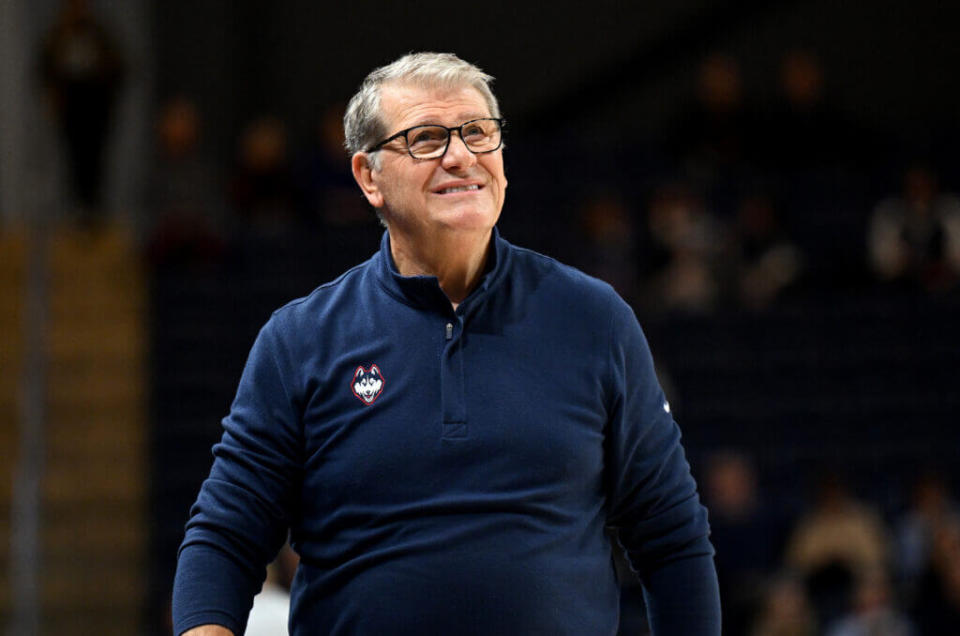
Geno Auriemma has been a stalwart of women’s college basketball for four decades, achieving success most coaches could only dream of.
In 1985 he took over a UConn program with just one winning season and has since led it to 11 NCAA Division I titles – the most in NCAA history.
He also has the most wins of any NCAA head coach after surpassing Tara VanDerveer last November. But the fire inside the 70-year-old remains as fierce as when he first arrived in Storrs 40 years ago, as his Huskies beat defending champions South Carolina 87-58 on the road last weekend.
On the latest episode of “The Athletic Women’s Basketball Show,” Auriemma joined Zena Keita, Chantel Jennings and Sabreena Merchant to chart how the game has changed over his four decades at the top. Below are a few highlights from the conversation, you can listen to the full interview on the podcast feed.
Jennings: I’m curious looking at the current state of women’s college basketball and the changes that we’ve seen in the last few years. How would 2025 Geno Auriemma explain the college basketball landscape to the 1985 Geno, who took the job at UConn without even seeing what the gym looked like?
Auriemma: Yeah, that’s like trying to explain in 2025 what it was like to live in the Roman Empire. It’s ancient history and hard to describe to anyone that wasn’t there because you had to be there to believe the landscape now relative to then. At Connecticut, we were just trying not to finish eighth or ninth in our league. There were nine teams in the Big East, so we were trying to make sure we didn’t finish eighth or ninth because that’s where they finished every year. That was the play-in game in order to get into the Big East tournament. And we accomplished that goal as we didn’t finish eighth or ninth. Teams like Providence, Villanova, Syracuse, BC (Boston College) and Saint John’s were good teams back then, but none of them were national players by any stretch of the imagination in the national landscape. I don’t even know if there was a Top 25 Poll back then by Mel Greenberg (the reporter who pioneered the first AP Top 25 Poll for NCAA Division I women’s basketball in 1976). That’s how old this thing is.
There may have been Tennessee, Old Dominion, Louisiana Tech, Virginia, NC State and Maryland. It was all very regional and there was a very non-national view of women’s basketball. The NCAA Tournament was 32 teams, I want to say. Just to give you an idea, we went to the Final Four in 1991, which meant that we were the first team ever from north of the Mason-Dixon line to go to the NCAA Final Four. The first team from north of Philadelphia at least. There were 8,000 people at the Final Four played in Lakefront Arena in New Orleans, and there was one TV camera there that I know of that came from Connecticut. So compared to today, it was intramurals versus what is now major news, major coverage and major interest. And it’s only taken 40 years.
Merchant: Where was the Big East tournament those days when you were trying to get out of the eight, nine play-in games?
Auriemma: The Big East tournament used to rotate among each member school, so every school got to host it which is crazy. We just played at Seton Hall last night — it seats 1,800 people — and that was the first Big East tournament that Connecticut won in 1985. I’m sorry, 1988-89 was our first Big East championship, and it was at Seton Hall. The game wasn’t even on the radio, I think it might have been on the WHUS campus radio station who might have broadcast the game. Then the tournament came back there 10 years later in 1995 and everything had changed. We were undefeated, we were favorites to win the national championship, and still, it’s the Big East tournament played in front of 1,800 people. And 1,700 of them were bused down from Connecticut.
A lot has changed, and in so many ways the world is different. There was no way to communicate back in 1985, there was no (cell) phones (laughs), so you found out the next morning how everybody did. Every kid that was on our team was from within driving distance. The kid who lived farthest away on our team in 1985 was from New Jersey when I first started. My mother was a teenager during World War II living in the hills because the Germans took over their house in Italy. Then the day she died in 1992 she had a cell phone. So UConn women’s basketball and the rest of basketball is living in a place that didn’t exist in 1985, not even in people’s imagination.
Jennings: How would you have explained NIL, the transfer portal and revenue share to that guy who was playing in Seton Hall in front of five people and a bunch of reporters with typewriters? Because that’s what it sounds like.
Auriemma: It’s hard to explain. I shouldn’t say it’s hard to explain, but maybe it is. Anybody that doesn’t want to understand, won’t understand. But coaching in 1985 and coaching today, at least the level that we’re coaching at in college basketball, is the difference between riding a tricycle and flying a jet plane. You can’t even imagine the difference, the landscape, how it’s changed and why so many coaches are dying to get out of the game because it’s unmanageable. … It’s unfair to the mid-majors. It’s unfair to the schools that don’t have the money. It’s unfair to everybody except the 40 or 50 schools in the country that can afford to live in that world. It’s unfair to the rest of college sports. But it’s also unmanageable. You can’t manage it because there’s no rules, and no one can operate when there’s no rules. We try to have rules on our team, but it’s hard for those kids to understand the rules of the team when in the rest of their college experience, there is no rules.
Whatever you want to do or have the ability to do at your school, that’s what you do. Nobody worries about any ramifications, so it’s unmanageable. Each and every year that this lasts (it becomes more difficult). The unmanageable part of it — and I’m not saying kids shouldn’t get paid, I’m not saying they shouldn’t make money off their ability to play basketball — but their ability to just pack up and leave anytime they want makes it unmanageable for the coaches. Everybody will say, ‘You have parity because more players move from one place to another.’ But in reality, that parity is going to go away when the teams that can spend the most money end up with the best players, so that parity is going to start going away. They say there’s parity in college football – that is the biggest joke in the history of sports that there is parity in college football. There’s only one sport that has parity and that’s the NFL. Everybody else is fooling themselves that there’s parity. So let’s see what happens.
This article originally appeared in The Athletic.
Connecticut Huskies, Women’s College Basketball, The Athletic Women’s Basketball Show
2025 The Athletic Media Company
EMEA Tribune is not involved in this news article, it is taken from our partners and or from the News Agencies. Copyright and Credit go to the News Agencies, email news@emeatribune.com Follow our WhatsApp verified Channel




